Ingrown toenails are relatively common problems, especially for those who often wear shoes too tight for their feet to breathe. Around twenty percent of all people may experience the condition at one point or another, its symptoms typically involving swelling and pain in the affected area. There are also cases where the nail can become infected, with people with medical conditions like diabetes at a greater risk of potential complications.
Typically, ingrown toenails occur when the edge or corner of the toenail grows and curves within your surrounding skin instead of outside. Common causes of the condition are toenail trauma, tight footwear, cutting the nails too short or at angles, poor hygiene, excessive sweating, and specific medications. It’s best to treat them immediately to avoid infections. The sooner it recovers, the better.
If the condition causes severe pain, infects the toe, or if the inflammation begins to spread, it’s a good idea to see your doctor for medical treatment, or it may result in further complications and an increase in the severity of the symptoms. However, in most cases, it’s possible to address ingrown toenails with little more than over-the-counter drugs and home remedies, which we’ll cover in this article.
Soapy and Warm Water

One of the most effective home remedies for treating ingrown toenails is to ensure that the affected area is clean by soaking it in soapy and warm water for around twenty minutes. Once done, the surrounding skin can be pushed back from the nail’s edge a little so you can treat the wound it caused. Remember to dry the food afterward and use anti-inflammatory and antiseptic tinctures, creams, and gels to soothe your skin and prevent any infections from occurring.
The primary goal of this treatment approach is to alleviate its symptoms and minimize the likelihood of infection while allowing the toenail to grow properly. It’s recommended to use Castile soap, but any will do. Some have reported the addition of Epsom salts to help ease and relieve some of the discomfort caused by the ingrown toenail. The cleaner the affected areas are, the less likely they are to hurt and the quicker they should heal.
In addition, a gentle massage of the foot may reduce inflammation and improve blood circulation. Ensure that the foot is completely dry because if it’s damp, it’s more likely to spread bacteria and get more infected, leading to further aggravation and painful complications.










